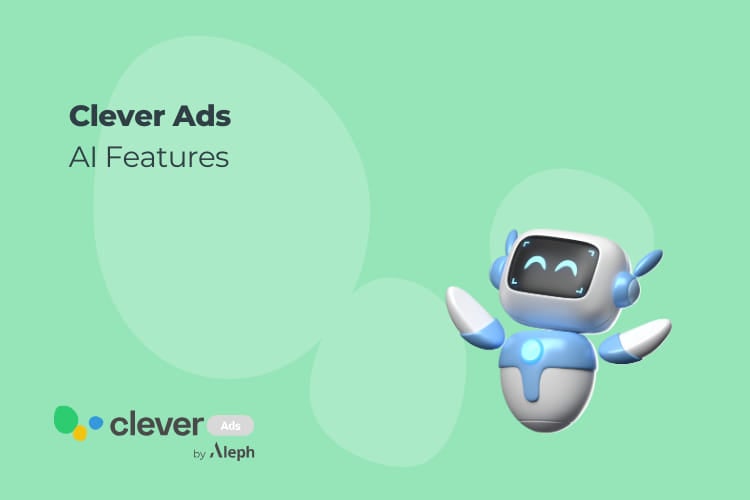AI features: how Clever Ads uses AI to help you with your advertising
Since its inception, the Clever Ads team has been pioneering the implementation of Artificial Intelligence (AI) in the world of advertising. With a track record of medaling in Machine Learning competitions in Kaggle, Clever Ads has been at the forefront of technological innovation. From the launch of GPT-2 in 2019 to today with GPT-4, the company has been constantly evolving, multiplying the capabilities of its team and developing tools that revolutionize the way advertising is done AI advertising! Read on to learn more about our AI features!
From before it was so cool
As we were saying, the Clever Ads team was accumulating several medals from Machine Learning competitions on Kaggle. So in 2019 it was instant to start with experiments when they launched GPT-2. Now GPT-4 is in every corner of Clever Ads. There has been a constant effort to increase tenfold, if not a hundredfold, the capabilities of every member of our team, from developers to marketing staff. It’s a race against OpenAI to bring the future of technology into the present. Six to nine months later, it becomes standard and they release an enhancement that they distribute to everyone.
When we started with the implementation of GPT-3, we did it on all possible fronts: from successful keyword generation and text ads based on others, to natural language SQL queries, a chat mode and assisting our Account Managers to answer support tickets. By 2022, even before there was a chat API, we had integrated it into Slack
so that everyone could use it internally.
Lessons and stumbling blocks
Our biggest challenge has been, without a doubt, to teach this to every single person. Evangelizing Artificial Intelligence is tough. We have encountered skepticism, privacy barriers, concerns about GDPR and genuine fears about job automation. That last part is very correct and from the beginning we have designed everything with an extreme level of privacy, complying with all data protection regulations. The most shocking thing for me has been to demonstrate the usefulness of one of these tools to colleagues, perceive real excitement and, except for some pioneers, then see that they are not used again for months. Once they proliferate to other platforms and become distributed, they suddenly become more widely used.
The good thing is that the people who did use it started to accelerate quickly: junior programmers outperforming senior programmers months later, Account Managers who could spend more time serving clients well instead of writing “5 more headlines”, non-programmers using Code Interpreter to do Data Science with huge Microsoft Ads reports, allowing them to make decisions and improve their recommendations.
We tried to make training in the use of these tools scalable but it almost required personal training or group meetings to talk openly and raise questions. In some strange way, many people were too busy to spend an hour to streamline their day-to-day lives and have less work to do. Today the advantages of using Artificial Intelligence everywhere are more obvious. Tomorrow it will be more so, and so with each passing day.
It has been like trying to bring the future in one year, only that many people have realized it a year later. The lesson learned is that developing tools using these models is 50%, educating every person on these AI tools is the other 50%.
AI for internal and external use
Some time ago I tried creating a personal advisor with its own notes about me. These notes act as a memory that updates itself with each conversation. This memory feature can be used in companies to personalize the customer experience. These notes can be of many types: basic customer data, latest reports and statistics from your campaigns, feedback and opinions, past problems, summary of all your contacts with customer service, etc. This will soon be all over Clever Ads to support our Account Managers, whether the customer speaks via email, chat, Slack, the mobile app, etc. Personalizing the experience as much as possible and enriching each response to what each user needs. The next step will be “a memory of memories”, that is, being able to group memories to understand what is more of a priority to build, where there starts to be a problem, which groups would prefer what and literally ask them questions or simulate their needs. Sound weird? Maybe. But in reality it will translate to better individualized attention. I think every company will want this soon.
Internally there are many tools: suggest answers to support emails to the Account Manager taking into account all past emails to save time, always having the Account Manager in control of what to answer, of course… Read thousands of news daily and send them only to those who might be interested explaining why… Add a layer of intelligence to the assistant in Slack/Microsoft Teams/Google Chat… A centralized customer memory wherever you talk… and prepare all this as a white label so that other agencies can enjoy it without having to develop it again. We are also starting to experiment with video and creating quality short spots.
Clever Ads GPT
We recently released the Clever Ads GPT. This GPT allows both customers and non-customers to chat directly with an expert digital marketing assistant with a ChatGPT Plus account. You can also create text and images for campaigns or analyze your website. If you are a client you will be able to audit your campaigns from the chat, providing personalized advice and analysis of your reports.

Looking into the future
I believe that chat is the new UI and that the web will tend to be browsed by more programs and less by people (a language model can visit 10 links and give you a summary quoting what’s relevant), especially seeing the tsunami of generated and artificial content to hack SEO. That’s why we take a hard look at what Microsoft will do by integrating ads into Copilot (formerly Bing Chat), taking for granted that Google won’t be the pioneer in its own cannibalization of its juicy margins. In fact it is clear that Google is 1-2 years behind in making AI tools available to the public. Microsoft doesn’t care if the experiment of changing search advertising goes wrong or right, but for Google it is its economic backbone.
Creativity is tending to cost 0. Almost everyone thinks about flooding the Internet with mediocre advertising content to see what has better statistics. I think it’s better to focus on generating extremely high quality content: tweets that you want to read, food with impossible images, fashion with eye-catching landscapes… A golden age of Mad Men type advertising has to come back, memorable and creative. Now it’s cheaper and faster than ever.

In the Clever Ads Artificial Intelligence team we will keep trying to surf this wave, being up to date with every technological novelty and trying to anticipate as many months as possible to the future. We also believe that everything is going to change, that we will soon see the capabilities of something close to a General Artificial Intelligence and that the role of many service companies will be questioned. One thing that is clear is that 7 billion humans need to be educated on how to use these tools and that it is as important to teach how to use them as it is to develop solutions with them. Also that it is not necessary for 100 companies to develop the same solution, it is only necessary for one to do it and share it with the rest for a small fee. Clever Ads can be an excellent developer for other marketing agencies.




